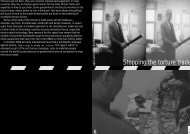CROWD CONTROL TECHNOLOGIES - Omega Research Foundation
CROWD CONTROL TECHNOLOGIES - Omega Research Foundation
CROWD CONTROL TECHNOLOGIES - Omega Research Foundation
Create successful ePaper yourself
Turn your PDF publications into a flip-book with our unique Google optimized e-Paper software.
currently available is not sufficient to allow the use of PAVA as an incapacitant in the United Kingdom<br />
at present(. 120 However, Civil Defence Supply Ltd has been awarded 45,000 from the UK Department<br />
of Trade and Industry to research PAVA as an allegedly safer alternative to CS to become what the<br />
company hopes will be the incapacitant for the millennium. 121<br />
Finally, in regard to safety, it is worth recalling that way back in 1975, the Stockholm International<br />
Peace <strong>Research</strong> Institute was warning about delayed toxic effects from chemical warfare agents<br />
including tear-gases. 122 Not all the effects of using these chemicals will emerge straight away and just<br />
as the full implications of tobacco and asbestos only became apparent many years after their popular<br />
usage, so might be the case with chemical crowd control agents. Given the overall costs of litigation<br />
associated with tobacco and asbestos, it is worth reminding ourselves that the precautionary principle<br />
pays off in the longer term.<br />
4.1.2 Hazards of Dispensing Excess Levels of Chemical Irritant There are many instances of the<br />
police and the military using CS either excessively or indiscriminately. For example, the South Korean<br />
government admitted to using 351,000 canisters and grenades of CS throughout the major cities, in<br />
June 1987. 123 There are reports of demonstrators passing out or experiencing heart attacks during<br />
episodes where helicopters were used to spray teargas. 124 No official scientific studies on the biomedical<br />
impacts of this CS barrage on the health implications for those working in Seoul, including the<br />
police themselves appear to have been published either then or since. 125 However, in 1999 the South<br />
Korean authorities in Seoul announced a policy of not using CS as a crowd control option. (See Section<br />
7).<br />
When such indiscriminate mass sprayings involve different riot agents, the health risks are<br />
compounded. For example, severe health problems were reported in at the anti WTO protests in<br />
Seattle last December, where the police used a combination of CS,CN and OC. 126 Even some of the<br />
manufacturers of these products warn about the synergistic consequences of such mixing )which can<br />
prove harmful or even fatal in real life situations(. Zarc International also asserts that a mixture of CS<br />
with OC in pepper sprays has caused )documented eye injury and blindness(. 127<br />
The issue of excessive delivery of agent to subject also touches on product design and actual<br />
adherence to technical specification. For example, in November 1996, a UK Channel 4 Dispatches<br />
programme found that the concentration of CS in UK sprays at 5%, was five times higher than similar<br />
sprays in the USA and the flow rate was also five times greater which means that anyone targeted in<br />
the UK would receive 25 times the amount of chemical irritant used in America. 128 Even that figure may<br />
be an underestimate. An internal Home Office note suggests that the French manufactured CS sprays<br />
may contain an even higher concentration than the stipulated 5%. Spot checks carried out by one UK<br />
police force revealed concentrations of CS between 5.4 and 6.8 per cent, ie a CS )dump rate( of<br />
between 27 and 34 times that used in the USA. 129 The Home Office has asked SAE Alsetex, which<br />
manufactures the spray, about their alleged failure to ensure product quality control in terms of the<br />
higher than stipulated concentrations. According to the note of February 1997, the company simply said<br />
that they had not been measuring the concentrations of CS in their canisters up to that point. The UK<br />
Home Office admitted that it had no system of regular spot checking these devices. When forces do<br />
undertake such an inspection the results are worrying. In December 1997 another force checked their<br />
canisters and found concentrations of 8.5 % or a )dump rate( of 42.5 times more than would be<br />
permissible in the USA.<br />
Other hazards of excess application of chemical irritants are related to the development of<br />
tolerance. Such tolerance has been associated with people taking medication because of mental health<br />
problems and/or recreational drug users, factors which can diminish the effectiveness of the chemical<br />
irritants. Why tolerance occurs in these groups is unclear but it may be related to reduced anxiety. 130 A<br />
recent report by the UK Police Complaints Authority has recommended that where mental illness is<br />
involved )that training should emphasise the risks involved in using the spray on those who are<br />
vulnerable through mental illness, alcohol or drugs, and that the [CS] spray may not work in these<br />
circumstances and may also exacerbate a violent situation( and )that training should reinforce the need<br />
for consultation with family and mental health professionals where possible, to find alternatives to the<br />
xxiv




